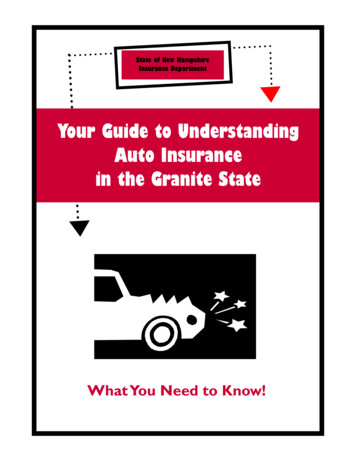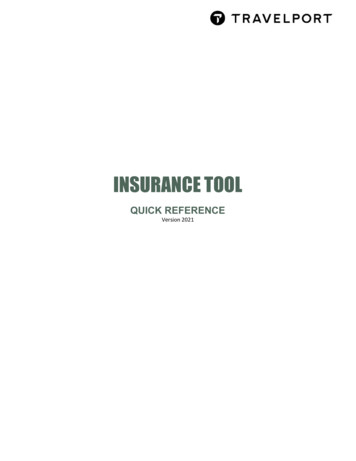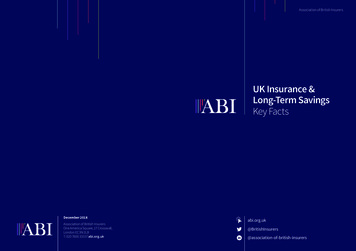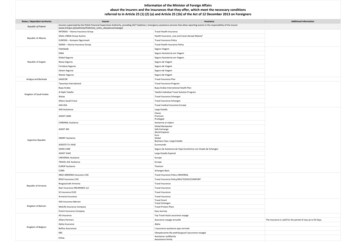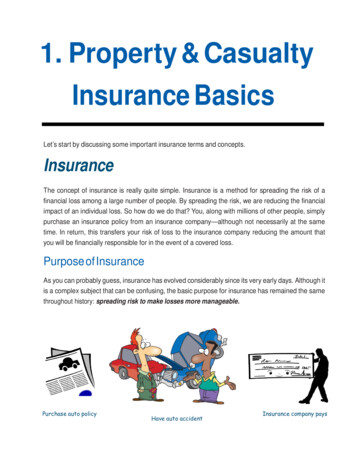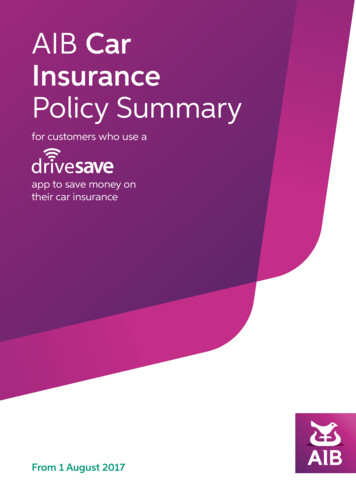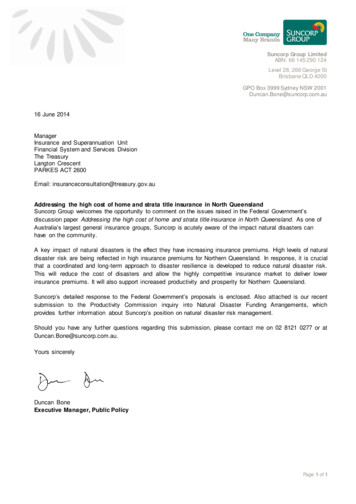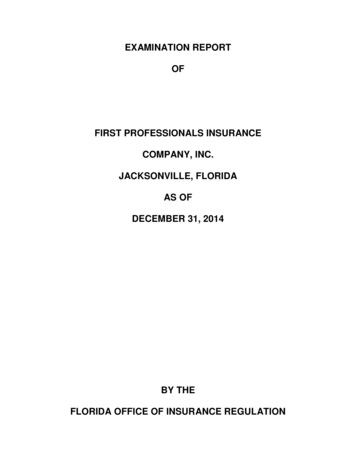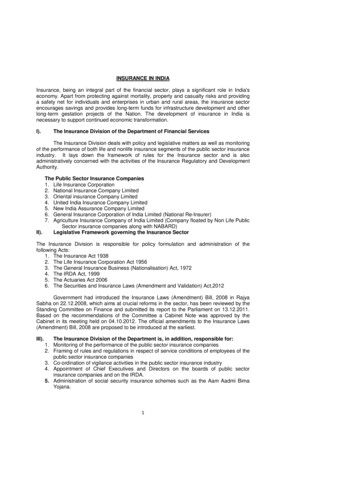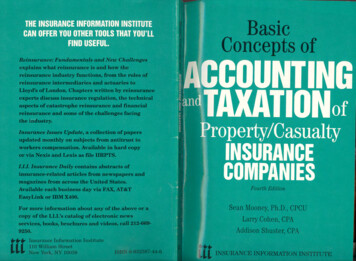
Transcription
BasicConcepts MPANIESFourth Edition1995Sean Mooney, Ph.D., CPCUInsurance Information InstituteLarry Cohen, CPAThe Mutual Life InsuranceCompany of New YorkAddison Shuster, CPACoopers & LybrandtttInsurance Information Institute Press
L, Contents)0Chapter 1ForewordvIntroduction1The Products of AccountingFundamental Accounting PrinciplesThe Regulatory Origins of InsuranceLibrary of Congress Cataloging-in-Publicationinsurance4th ed.companiesand taxationof property/casualty/ Sean ]dooney, Larry Cohen, Addison Shuster.--Chapter 3p.cm.Includes bibliographicalSpine title: accountingISBN 0-932387-44-6referencesand index.and taxation.1. Insurance, Property--UnitedStates--Accounting.2. Insurance,Casualty--UnitedStates--Accounting.3. Insurance, Property-Taxation--UnitedStates. 4. Insurance, Casualty--Taxation--UnitedStates.I. Cohen, Larry.II. Shuster, Addison.III. Title.657' .836--dc20Chapter 4Chapter 5Companies,Copyright1995 by InsuranceAll rights reserved.and Taxation of Property/CasualtyFourth EditionPrintedInformationChapter 6InstitutePress.in the United States of AmericaThe Insurance Information Institute is a primary source for information,analysis and referral on insurance subjects. It disseminates thisinformationInformationin several ways, including throughInstitute Press.the books of the Insurance11Revenues and ExpensesThe Annual Statement1113Liabilities and Surplus21LiabilitiesUnearned PremiumsLoss uranceElements of PIC Insurance AccountingCalculating Loss ReservesReserves for Loss AdjustmentOther LiabilitiesIV Title: accounting and taxationHG8077.]d671995Basic Concepts of AccountingAccounting46DataChapter 2]doone Sean,1945Basic concepts of accounting1ExpensesSurplusAssets41BondsStocksOther InvestmentsOther Assets474950Income Statements53Statement53of Income42Income's Impact on Surplus56Federal Taxation59Discounting of Loss ReservesFresh StartUnearned Premium Reserve60636465666668Treatment of Tax-Exempt Income and DividendsRepeal of Protection Against Loss AccountThe Alternative ]dinimum Tax (A]dT)Tax Treatment of Salvage and SubrogationCaptive and Self-Insurance Issues70
Chapter Accountingand seof the interestof legislators,and the publicinthe accountingpracticesand taxationtheofmediaproperty/casualtyinsurance companies, the Insurance Information Institute Press is publishing this 1995 expanded edition of a book focusing on the subject.This book joins the long list of products of the Institute, whose purpose is to explain subjects relating to the property/casualty insuranceindustry, a financial linchpin of our society.In this edition, the book has been revised to include new developments in accounting and taxation. In addition two new chaptershave been added. Chapter 7 on life insurance accounting presentsthe key elements of that topic, so that readers, particularly thosewith property/casualty insurance backgrounds, can get a sense ofhow the accounting system works for the life insurance industry.Chapter 9 on financial ratios describes the key ratios that areused in analyzing and reporting on property/casualty companies.The products of the accounting system end with financial statements. However, managers, analysts and regulators utilize financialratios based on the accounting products to describe and understandthe financial conditions of insurance companies. This chapter provides the reader with an understanding of the major ratios used inthe property/casualty insurance industry.The book was written by Dr. Sean Mooney, the Institute's seniorvice president and economist, with the technical assistance of LarryCohen, CPA, vice president with Mutual of New York, and AddisonShuster, a partner with Coopers & Lybrand. Because the goal forthis text was to explain technical ideas in nontechnical language, itwas especially important to have Mr. Cohen's and Mr. Shuster'sexpertise to ensure accuracy.v
IINTRODUCTIONWe are also grateful for the assistance of John Dunn, senior auditmanager at Coopers & Lybrand.The Insurance Information Institute, an educational, fact-findingand communications organization, is committed to expanding its reputation for distilling complex information into coherent, readabletext through all of the books of the Insurance Information InstitutePress.Gordon StewartPresident1IntroductionA ccounting is a systemrecording,verifying an.l"1organization'sfinancialofhistory.It isanalyzinga means andof communicatingfinancial facts to people who need such information to make decisions. Accounting today is a highly technical and complex processwith a sophisticated theoretical base and a large body of widelyaccepted principles and practices.The Products of AccountingAccounting results in two basic products: management reports thatserve the needs of decision makers within the company, and financialreports for interested persons outside the company. Investors, creditors, suppliers and other external groups need information to makedecisions concerning their relationship with the company. Financialaccounting provides information relevant to those decisions, such ashow the company has performed this year compared with last year.By evaluating performance (operating results), investors and creditors can get guidance on the financial health of the company, and onits ability to grow and prosper. Accounting also provides informationabout a company's current resources, the claims against thoseresources, and the effects of business transactions and other eventson the company's general financial condition. In short, a financialreport makes it easier for interested parties to make rational decisions about the company's future and their own.vi1
unting is not the same as financial or management analysis.Accounting statements are like a medical checkup - they tell the"temperature," "blood pressure" and "weight" of a company - but a"doctor" still must interpret the results. For example, an accountantmay report that an insurance company has a profit of 10 millionthe value of total assets declines, the owners usually take the loss,but the company still has the same obligations to its creditors, whoseclaims remain unchanged. In summary, the balance sheet consists ofthree parts: assets, liabilities and owners' equity.A company's operating results are presented in an incomeand capital of 100 million. Given these figures, a financial analystcan then calculate that the rate of return of this company was 10percent ( 10 million divided by 100 million). The financial analystcould further conclude that this rate of return was sub-par, sincecompanies in the same business had a much higher rate of return. Adiscussion of common financial ratios calculated on the basis ofstatement, a record of operating activities during the precedingyear. The income statement records the revenues received from salesand the costs involved in making those sales, as well as otherexpenses and sources of profit, such as taxes and investments.The income statement is typically followed by the annualretained earnings statement. This is essentially a statement of howthe owners' equity changed during the course of the year. At its simplest, it shows the accumulated retained earnings at the end of theprevious year and adds to that the current year's net profit, less dividend payments, to arrive at a current accumulated retained earn-accounting data is provided in chapter 9.A company's financial condition is reported in a balance sheet,which gives a picture of the company's economic condition at onemoment in time.In its simplicity and sophistication, the balance sheet has few ifany competitors outside the world of science. Its rationale is basedings figure. This figure also appears in the owners' equity section ofthe balance sheet.on a simple formula: Asset dollars are equal to claims against assets.An asset is anything wholly owned or effectively controlled by a company. For most corporations, claims against these assets are held bytwo distinct parties, the owners of the company and outside lendersor creditors of the company. The claims or interests of the owners ofThe annual financial report of a company is developed from datagathered through daily bookkeeping procedures. These proceduresrecord such details as the purchase of a typewriter and the receipt ofa check from a customer. A basic principle of bookkeeping is doubleentry. If cash is spent to purchase a typewriter, then this transactionis recorded in two places. It is recorded as a reduction in the cashaccount and as an increase in another asset account, such as one foroffice equipment. This double entry system is a very powerful controlthe company are known as owners' equity. The claims of creditorsare called liabilities. Liabilities include major items such as bondissues and bank loans. However, if a typewriter is purchased oncredit, the credited amount is considered a liability. Of note, forinsurance companies, major claimants against the assets of the corporation are policyholders and others who have suffered a loss.The word "balance" in "balance sheet" refers· to the conceptbehind this document, the fact that any addition to or deductionfrom the total of the asset side of the balance sheet results in anequal rise or decline on the equity and liability side. An increase intotal assets will cause an equal increase either in the creditors'and checking mechanisll), and it also serves to preserve the basic.balance sheet equality between total assets and total claims againstassets.The financial report of a company deals with the broad generalcategories, which have been developed from the detailed bookkeeping process. Throughout this book, we will be discussing these broadcategories.claims (the company's debts, for example) or in the owners' equity. If23
BASICCONCEPTSOFINSURANCEACCOUNTINGFundamental Accounting PrinciplesAll corporate accounting is governed by rules established by theFinancial Accounting Standards Board (FASB) and the AmericanInstitute of Certified Public Accountants (AICPA). Publicly-ownedcompanies are required by the Securities and Exchange Commissionto follow these rules.These generally accepted accounting principles (GAAP) require,for example, that financial reports be understandable by knowledgeable people and include all significant information (full disclosure).Other general principles require that accounting procedures be consistent and objective. Practical principles set rules for, among otherthings, determining the value of assets and the point in time whenrevenues (a paYment in advance, for example) become earnedincome (on delivery ofthe product or service). The latter is known asthe revenue recognition principle. The basic concept of revenuerecognition is that revenue is recorded at the time when anexchange is made or service is provided - a newspaper sold or aconcert performed - rather than when paYment is made.One practical principle is of particular importance. The matching principle is a basic principle of GAAP accounting, the usualform of accounting for nearly all businesses. This principle dealswith matching expenses with revenue: It indicates when expensesshould be recorded. The matching principle states that, in determining net income for a given period, the accountant should matchexpenses with associated sales or revenue generated in that period.For example, a magazine publisher does not earn the money paid forsubscriptions until the magazines have been delivered to their buyers (revenue recognition principle). Under the matching principle,the publisher's expenses for stocks of ink, paper, and other items arenot charged against income at the time of purchase, but only whenthey have been used to produce delivered magazines.The assumption behind the matching principle is that a companymay have to make sizable paYments before it can make a single saleassociated with those expenditures. If those expenditures were imme4INTRODUCTIONdiately charged against the company's assets, the company mightappear to be in a very poor financial condition when, in fact, it heldsubstantial inventory and was on the verge of making a sizable profit.GAAP recognize that industries' accounting needs vary and thatsome require special accounting practices. Mining corporations, forexample, use special procedures to report the peculiar fact that theirinventory, their stock in trade, is irreplaceable.Other industries have significant responsibilities to the generalpublic that go beyond GAAP's basic concern for investors. Theseindustries - utilities, banking and insurance, for example - areusually also subject to extensive regulation by public authorities. Tothis extent, accounting systems have been developed to meet specificregulatory requirements for greater disclosure and other specialneeds of the public.As one of these special industries, property/casualty insurance hasspecific statutes and regulations setting out accounting requirements.The effect of these practices, known as statutory accounting, is toemphasize the insurance company's present solvency, not its potentialfor profit. This solvency emphasis is aimed at ensuring that a company will have sufficient readily available assets to meet all anticipatedinsurance obligations. Under these requirements, an insurance company is required to recognize certain major expenses, such as agents'commissions, before the income generated by them is earned.This conservative approach reflects the viewpoint that the role ofan insurance business is in many respects comparable to that of afiduciary. A fiduciary, in law, is a person who is legally obligated todischarge faithfully a responsibility of trust toward another.Similarly, an insurance company has a responsibility of trust towardits policyholders. Insurance regulation allows for moderate profitmaking by well-managed companies, but the underlying assumptionof regulation is that the role of the insurance business is to protectother people's assets - even at the expense of shareholders.This solvency focus of property/casualty insurance accounting isbasic to regulators. To fully understand this regulatory perspective on5
BASICCONCEPTSOFINSURANCEACCOUNTINGinsurance accounting, it is necessary to look briefly at the history ofinsurance with particular reference to the development of insuranceregulation.The Regulatory Origins of Insurance AccountingProperty and casualty insurance is basically a sharing of risks sothat, in the event of a loss, the burden is not borne by one individualor business alone, but is shouldered by a large number of other peopleas well. This sharing of the risk is explicitly recognized in the mutualform of insurance company, which is owned by its policyholders.Other (stock) companies are owned by shareholders, who put theircapital at risk alongside the premium-paying policyholders. In eithercase, the essence of insurance is mutuality, since insurers collect payments from many people who face similar risks, and those paymentshelp to cover the losses of victims.As modern insurance practices began to develop in medievalEurope, both forms of insurance - strictly mutual and stock ownership - grew up side by side. Medieval merchant and craft guildsestablished funds to cover the fire and shipwreck losses of theirmembers, and communities created reserves to pay for fire losses.Marine insurance was flourishing in Italy in the 14th century andspread rapidly throughout Europe. A marine insurance contract wasusually signed by several insurers, under a line drawn on the contract. This is the origin of the term "underwriter." Stock companiesbegan to sell insurance in England in the early 18th century andsimilar companies soon sprang up in the American colonies. Liabilityinsurance, that is, insurance against claims arising from harmcaused by the insured to the person or property of another, did notappear until about the middle of the last century.Increasing prosperity in the late 18th and early 19th centuriesmade insurance necessary for a larger number of people. TheIndustrial Revolution saw an immense increase in the value of plantand equipment and made both more expensive to replace in theevent of fire or other disaster. The expansion of trade and the greater6INTRODUCTIONvolume of goods transported increased the size of potential transitlosses, while at the same time the value and amount of personalproperty increased for ever-growing numbers of people.The expansion of insurance followed, and many private insurancecompanies were formed to fill the need for broader coverage withhigher limits. Competition among these early companies was fierceand sometimes led to unrealistic premium rates designed to undercutcompetitors. Rates were sometimes set so low that insurers were, ineffect, operating below cost. Sometimes, they went out of business.However, even conservative companies were hard pressed to determine expected losses. The experience and sophisticated mathematical tools that today enable actuaries to anticipate losses within moreor less predictable margins of error were in their infancy in the earlydays of insurance. The consequences of early insurance practiceswere sometimes catastrophic. A small company with too many policies written in one locale and a capital base depleted by the costs oftrying to sell ever more policies, could easily be wiped out by a singledisaster. The first fire insurance company in America, established in1735, was rendered bankrupt by a major fire loss six years later.As it became increasingly clear that the solvency of insurancecompanies was an essential element of public confidence in futurestability, public authorities stepped in to oversee the industry. Thefirst formal insurance regulatory body was established by NewHampshire in 1851. Within two decades, at least 18 other states hadformed similar regulatory bodies and at least nine more had lawsrelating to insurance regulation on their books. Today, statutory regulatory bodies operate in all 50 states, the District of Columbia, andthe offshore territories of the United States. Their functions, thenand now, have been to license insurance companies, to monitor theiractivities, to approve the forms and conditions of policies, and tooversee the setting of premium rates so that they are neither unreasonably high nor so low as to threaten insurance companies' solvency.The early regulation of the insurance industry demonstrates thatthe general public and the business community saw the industry in a7
BASICCONCEPTSOFINSURANCEACCOUNTINGspecial light. It stood outside the general American objection to thegovernment regulation of private enterprise, an objection that wasparticularly strong in the latter half of the 19th century. Insurancewas seen as not just another service provided by entrepreneurs, buta vital underpinning for the growth and well-being of the Americaneconomic system.One of the reasons that it is so important to regulate insurance isthat it sells its product before most of the costs of the product havebeen incurred. Most corporations expend funds to develop and manufacture products with the hope of selling them at a price higherthan their costs. It is easy to accurately measure the costs as theyare incurred. The risk to management is whether the sales price,which must be estimated during the manufacturing phase, exceedsthe cost incurred. The opposite occurs with insurance. Managementof an insurance company must estimate future costs for payingclaims at the point the policy is sold. Their revenues can be specifically measured at this date. The costs incurred subsequently for paying claims are difficult to calculate. Because insurance companiesget cash from the general public up front in return for the promise topay claims, in some cases, many years later, it is especially important to the public that management act prudently to ensure the solvency of the company.State regulation was strengthened in 1869 when the U.S.Supreme Court, in the case of Paul vs. Virginia, ruled that insurancewas not a transaction in interstate commerce. That ruling meantthat the insurance business did not fall under the interstate commerce clause of the Constitution and thus was not subject to federalregulation. Nevertheless, there were numerous challenges to the1869 Supreme Court decision as well as reviews by Congressionalcommittees. Ultimately, the ruling was overturned in 1944, when theSupreme Court determined that the South-East UnderwritersAssociation (SEUA) was in violation of the Sherman Anti-Trust Actand guilty of price-fixing and restraint of trade. The SEUA had beenfounded and supported by insurance companies to study patterns ofl8INTRODUCTIONlosses and to set rates for different kinds of property insurance.Those rates were then adopted by insurance companies with theapproval of the southeastern state regulatory bodies.The ruling in the SEUA case was a severe blow both to theinsurance industry and to the primary assumptions of state regulation. As noted above, one of the functions of insurance regulatorswas to see that premium rates generated sufficient revenues to coverpotential losses. Rate setting is a complex and expensive statisticaloperation that smaller companies cannot perform efficiently themselves, even if they have sufficient capital to finance the process.Because the validity of loss statistics increases in proportion to thenumber of cases considered, it made excellent sense for insurancecompanies to pool their loss experiences and to determine adequaterates. Many states required insurance companies to belong to anduse the rates set by such associations as SEUA.Congress moved swiftly to protect the insurance industry fromthe worst effects of the Supreme Court ruling and to preserve theprinciple of state regulation. In 1945, it passed the McCarranFerguson Act, which declared that federal fair trade and antitrustlaws would apply to the insurance industry only "to the extent thatsuch business is not regulated by state law." To meet the provisionsof this act, state legislatures soon passed new laws relating to insurance regulation based on a model developed by the NationalAssociation of Insurance Commissioners (NAIC). As a result, presentinsurance statutes and regulatory procedures are similar from stateto state.The general agreement among the states on fundamental regulatory principles, together with the basic unity of accounting principles, has led to a general uniformity in accounting procedures amongthe states. This uniformity is largely the work of the NAIC, foundedin 1871 as the National Convention ofInsurance Commissioners.One of the first acts of that organization was to establish a permanent committee to develop a uniform accounting method for insurance companies, and over the years the Convention and its successor9
URANCEACCOUNTING(the NAIC) continued to develop and refine insurance accounting with theaim of improving regulators' knowledge of the stability and solvency ofindividual companies.Insurance accounting is called statutoryaccountingbecause itspractices are prescribed or permitted by law or statute. Generally, thebasic assumptions and practices of statutory accounting are similar tothose of ordinary business accounting under generally accepted accounting principles. Where variations do occur, they usually are extensions ofthe emphasis on current solvency.2Elementsof AccountingPICInsurance ebasicfinancialsource ofreport,informationinsurancecompanyis the annualcalled ontheanAnnualStatement.Sincethisis a lengthy and detailed document, it is perhaps better first to get abroad overview of the financial accounting system used by insurancecompanies. Therefore, this chapter begins with a highly simplifiedschematic description ofthe flow of revenue and expenses in a property/casualty insurance company on a statutory accounting basis. (Seenext page.)Revenues and ExpensesAn insurance company must establish a policyholders' surplusaccount of a certain amount in order to be granted a license by thestate in which it intends to be domiciled. This surplus consists of capital paid in for stock and a capital surplus (the amount paid for stockover par value) or, in a mutual company, of amounts loaned or paidinto the company by policyholders to create the surplus. The policyholders' surplus serves both as an extra base of resources in case ofcatastrophic unexpected losses and as the company's working capitalfor expansion.Premiums paid by policyholders are the primary source of insurance revenues. These premiums are classified as deferred revenuesand assigned to an unearned premium reserve. They becomeearned income on a pro rata basis over the life of the policies. By way1011
ASICCONC E PTS0 F I NSU R A NC E ACCOUNt ,ELEMENTSRevenuelExpense Flow DiagramOF PICINSURANCEACCOUNTINGInsurance company pays commissionand other selling expensesof contrast, the company charges the whole of the commission immediately after the policy is written, rather than on a pro rata basis.This differs from GAAP accounting where the expense is charged toincome in relation to the premium earned. The solvency emphasis ofstatutory accounting views agents' commissions as funds that willCompany pays claims or creates lossreserves to pay unsettled claimsnot be available to pay claims and so requires that they be immediately expensed.Property/Casualty Insurance Companies (A Simplified Model)Policyholder pays premium'--,I Reserves.Company pays other business expenses2Company pays state taxes and fees3The premiums that remain are used for several purposes. Thelargest portion goes to pay claim losses and another significantexpenditure goes to cover loss adjustment expenses (such asadjusters' fees and litigation costs). An additional amount is used topay expenses of underwriting the business. What remains of earnedpremiums after these expenses have been accounted for is called theunderwriting profit (or loss). Underwriting profits may be furtherDividends to pOlicyholderssubject to distribution to policyholders in the form of dividends. Withcertain types of insurance, dividends may be paid even though thecompany was not profitable.Underwriting profit (or loss)Besides the profit (or loss) that a company makes on its underwriting operations, it may also gain income from investments.Investment gain4Funds, which arise mainly from surplus and from premiums whichare held until the payments are made for losses, are invested, primarily in stocks and bonds. The income from these investmentsPre-tax income or loss (Investmentgain /- underwriting profit or loss)Federal and foreignincome taxesAfter-tax income or lossDividends to stockholders.1. The excess of assets over liabilities.Addition to capital (surplus)to support future growth2. Costs of doing business-rent, data processing, telephones, salaries, etc.3. State and local taxes, licenses and fees.4. Includes interest, dividends, rents and realized capital gains. Investment income is earned oninvestments which are financed by the premium dollars set aside to pay claims and by thecompany's capital.5. Applies only in the case of capital stock companies.6. Reserves arise from two sources: unearned premiums and claims. Unearned premiums arenot shown in this diagram in the interest of simplicity.including realized gains or losses is added to the underwritingincome to produce the net pre-tax income (or loss) ofthe company.Following the deduction of policyholder dividends and federal andstate income taxes, the net after-tax income (or loss) is derived.After-tax income may be used to pay dividends to stockholders oradded to the policyholders' surplus where it will be used to financefurther growth.The Annual StatementThe details of a company's assets, liabilities, surplus, and operatingresults for the year are reported in the Annual Statement, known asthe Convention Blank, developed by the National Association of1213
BASICCONCEPTSOF INSURANCEACCOUNtINGELEMENTSInsurance Commissioners. This statement is sometimes called the"yellow blank" because of its yellow cover, which distinguishes it fromthe ''blue blank" used by life insurance companies. The statement isOFINSURANCEPICACCOUNTINGANNUAL STATEMENTFor the Year Ended December 31, 1994OF THE CONDITIONAND AFFAIRSOF THEan 133-page document designed to elicit information about all aspectsof the property and casualty insurer's business.NAIC Group CodeAfter an introductory first page, which lists the name ofthe company and its officers and directors, pages 2 and 3 are a balanceusingas the Port of Entry, made to theINSURANCE DEPARTMENT OF THE STATE OFPURSUANT TO THE LAWS THEREOFIncorporatedCommenced BusinessStatutory Home Officeing company. These four pages are reproduced on the followingpages.Main AdministrativeThe income statement and "Capital and Surplus Account" makeup the first page of an eight-page ''Underwriting and InvestmentMail Addressdevoted to details of premium revenues, losses and loss adjustmentexpenses. This information is set out by line of insurance, for example, fire, homeowners, workers compensation, etc. The premiumsearned during the year, changes in the unearned premium reserve,and the net value of premiums for policies written during the yearare spelled out in detail. (Net premiums are those remaining afterthe company has reinsured some policies with other companies.)Losses include not only the money paid out on claims but alsoknown claims that have not been settled and accidents that haveoccurred and not been reported to the company. The latter losses foreach insurance line are displayed in a column titled, "Incurred ButNot Reported" (IBNR). In many cases, there is a considerable delaybetween the occurrence of an accident a
Chapter 9 on financial ratios describes the key ratios that are used in analyzing and reporting on property/casualty companies. The products ofthe accounting system end with financial state ments. However, managers, analysts and regulators utilize financial ratios based on the
